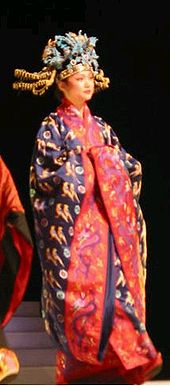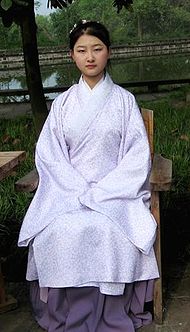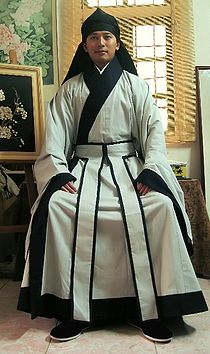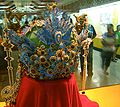
List of Han Chinese clothing
Encyclopedia
Garment
| Diyi Diyi Diyi is the traditional Chinese attire worn by empresses and crown princesses in the Ming Dynasty. It is a formal wear meant only for ceremonial purposes. It is a form of shenyi, and is embroidered with long-tail pheasants and circular flowers . It is worn with phoenix crown... |
 |
Diyi (翟衣), the formal wear of her imperial highness empresses and princesses |
| Daxiushan Daxiushan Daxiushan , translated as "Large Sleeve Gown", is a traditional Chinese attire for women and was most popular during Tang Dynasty amongst the Royals. After the golden age of Tang Dynasty had ended, the influence of Hufu , or clothing styles from Central and Western Asia, gradually weakened and Tang... |
Daxiushan (大袖衫), a formal wear of royal Chinese women | |
| Ruqun Ruqun Ruqun is an item of traditional Chinese attire primarily for women. It consists of a blouse and a wrap-around skirt . It has a long history, and has been worn by women since the Warring States Period.-History:... |
 |
Ruqun (襦裙), a common form of attire for women |
| Zhiduo Zhiduo (clothing) Zhiduo , or Zhishen , is the traditional Chinese attire for men. It is a form of casual wear, and is the most common form of attire for men in the Ming Dynasty. It was first worn in Song Dynasty. It is a full-length robe with side slits beginning below the waist, often with side panels at the... |
Zhiduo (直裰), a common form of attire for men | |
| Banbi Banbi Banbi also known as Banxiu is an item of traditional Chinese attire. It is a form of waistcoat or outerwear that were worn over ruqun, and had half-length sleeves. The style of its collar varies but it can be secured at the front either with ties or a metal button... |
Banbi (半臂), a form of casual outer wear for both men and women | |
| Beizi Beizi A beizi is an item of traditional Chinese attire common to both men and women, similar to a cloak. Most popular during the Ming Dynasty, beizi also known as banbi during the Tang Dynasty) are believed to have been adopted from Central Asia during the Tang Dynasty through the Silk Road when... |
Beizi (褙子), a cloak common to both men and women | |
| Chang'ao Chang'ao Chang-ao is the traditional Chinese attire for women. It is a form of formal wear, and is often perceived as a longer version of ruqun. However, it was actually developed from zhiduo during the Ming Dynasty, and is worn over a skirt. It is wide-sleeved, shorter than zhiduo and has no side panels ... |
 |
Chang-ao (長襖), the formal wear for women |
| Daopao Daopao Daopao/Xingyi is the traditional Chinese attire for men. It is a form of formal wear in the Ming Dynasty. It is a full-length robe with side slits beginning below the waist. There are side panels at the slits to conceal the undergarments. It is wide sleeved and has a belt... |
 |
Daopao/Xingyi (道袍/行衣), the formal wear for men |
| Shenyi Shenyi Shenyi is the traditional Chinese attire for men which advocated in Zhu Zi's Common Rites《朱子家禮》. The Shenyi Center of Chinese Medicine is named after it. It is a form of formal wear in the Ming Dynasty. It directly descended from the shenyi worn in earlier dynasties, like Han Dynasty... |
 |
Shenyi (深衣), the formal wear for men |
| Yuanlingshan Yuanlingshan Yuanlingshan is a form of traditional Chinese attire. It is a formal attire worn by men. It is also the most common form of attire for officials and nobles during the Ming Dynasty. The difference between civilian's and officials'/nobles' yuanlingshan is that officials'/nobles' yuanlingshan has a... |
 |
Yuanlingshan (圓領衫), a formal attire worn by men (civilian), most common form of attire for (both male and female) officials and nobles |
| Lanshan Panling Lanshan Lanshan is the traditional Chinese attire for men. It is a formal attire worn by scholars and students taking the imperial examination in Ming Dynasty. It is wide sleeved, has black edges, and has a round collar secured with a button. A crossed-collar undergarment must be worn. It may or may not... |
 |
Lanshan (襴衫), the formal attire worn by scholars and students (生員) taking the imperial examination |
Headgear
| Phoenix crown Phoenix crown A Phoenix crown is a Chinese traditional headgear for women. It was worn by noblewomen in the Ming Dynasty on ceremonies or official occasions. It is also the traditional headgear for brides. It is adorned with gold dragons, phoenixes made with kingfisher feathers, beaded pheasants, pearls and... |
 |
Phoenix crown (鳳冠), the headgear for noblewomen and brides |
| Tang official headwear Tang official headwear thumb|Tang Emperor Xuanzong wearing Tang style headwearThe headwear of Tang dynasty officials consisted of a black hat with two wing-like flaps. However, contrary to headwear of the Song dynasty, the flaps droop down.-See also:*Qing official headwear... |
Official headwear of Tang Dynasty | |
| Song official headwear Song official headwear thumb| [[Emperor Shenzong of Song]] wearing Song official headwearThe headwear of Song dynasty officials consisted of a black hat with two wing-like flaps. The thin flaps are stiff and straight, and could extend up to almost a meter each.-See also:... |
 |
Official headwear of Song Dynasty |
| Ming official headwear Ming official headwear The headwear of a Han Chinese official during Ming Dynasty China consisted of a black hat with two wing-like flaps of thin, oval shaped boards on each side called the wushamao... |
Official headwear of Ming Dynasty | |

